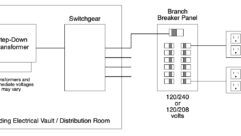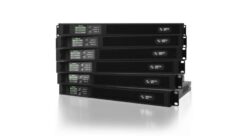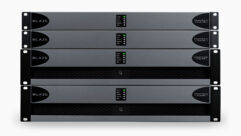

Technology Showcase: Remote-controlled and Networked Power Amplifiers
Jul 6, 2009 12:00 PM,
By Bennett Liles
New options for controlling your network from any location.
Camco Vortex 200V
With the coming of digital audio networks and new protocols augmenting existing serial control technologies, the world of power amplifier control and monitoring has become an increasingly exciting and innovative realm. New options abound for multiple-channel control and increasingly nuanced parameter manipulation by PC from any location. Coupled with new efficiency in power versus size and weight, power amplifiers represent a new crossroads of technologies that are still developing and bringing new ideas to life in the real world. Many are capable of using slide-in hardware to custom-design the units to interface with all the leading digital audio networks, and most also provide older and robust serial control and monitoring methods. Let’s have a look at what the field currently offers.
Related Links

This April, as a unique event in baseball history, a city’s two franchises both took up residence in new stadiums in the same season…

Powersoft Advanced Technologies Installation Series Amplifiers
Powersoft Advanced Technologies is proud to present the first two models of its new Installation series at this year’s InfoComm: the Duecanali5204 and Duecanali3904…

Audio Technology Transforms Museums
The word “museum” still tends to conjure up images of dusty books and statues connected by the occasional spider web. The technology and design dedicated to museums, however, has transformed this growing sector…
The 2-channel NE series amplifiers from Ashly Audio are designed for the installation market, and they offer 8V/4V stereo, 8V mono, and constant 100V output to match any installation scenario. The ne2400 provides 1200W per channel at 4V. The amps in this series are all equipped with XLR input connections and Speakon/Euroblock output connectors. Their balanced analog inputs can be used in bridged mono mode, and all models come equipped with an 80Hz high-pass filter, input-sensitivity switch, and Ethernet connections for use with Ashly’s Proteane software. Using this, units that have the factory-installed DSP module can be configured with DSP blocks for dynamics control, gain functions, graphic and/or parametric EQ, high- and low-pass filters, time delay, metering, and test signal generation. Assignable routing in the mixer section allows any input to drive any combination of outputs. Global parameters of a unit’s control surface and DSP section can be stored and retrieved from a file. Up to 35 individual DSP function parameters within and across both channels of the amplifier can be stored and recalled as a set using the Proteane software application on a control PC over the Ethernet connection.
The BGW Systems VX series amplifiers use the 15-pin faastLink D-sub interface for remote control and signal processing, enabling users to monitor crucial aspects of amplifier performance. The VX880 can put 900W into each channel at 8V, 1500W per channel at 4V, or 2300W in bridged mode, and it handles 1400W at 70V. The modes are set by switches on the rear panel. The unit produces less than 0.008 percent intermodulation distortion at 8V output. It demonstrates a rise time of 6µs and a slew rate of 20V/µs in stereo mode and 40V/µs in mono mode. The voltage gain is 34.7dB, and input sensitivity is 0.775Vrms for rated 8V output. Each channel includes a detented 21-position rotary control input attenuator in 1dB attenuation steps. The cooling is accomplished by a continuously variable fan speed, providing front-to-back air flow based on accurate temperature sensing on the heatsink modules. FaastLink was co-invented by a group of manufacturers including BGW Systems. The feature is standard on VX series amplifiers and optional on the C and GT series. The 15-pin connector accepts audio input, sends power to an external device, and sends signals monitoring amplifier output voltages and currents as well as other important parameters.
Power amps in the Vortex series from Camco use switched-mode power supplies (SMPS) to enable the units to pack more power into a smaller, lighter package. The Vortex 200V provides 3.2kW per channel at 4V, 6.4kW in monobridge mode at 8V, and 6.4kW in parallel mono at 2V. The rear panel includes the Camco Audio Interface (CAI), a bus system that connects with a two-core insulated cable through which all major functions can be monitored and controlled remotely using a master PC. With CAI, the user can mute and control the output level of each channel independently; switch the Vortex in and out of standby mode; and monitor temperature, output signal, clip, and output current. For moderate distances, a telephone cable with RJ-12 connectors can be used, and for longer control distances, RS-485 can be used. Using the second CAI connection, the control signals can be looped onto additional Vortex amps or other CAI-controlled devices. A linear network topology is recommended with 100V termination at its end. The CAI address selection procedure is performed on the front panel using a recessed enter switch with visual indication on the associated front-panel LEDs.
The Ci series from Crest Audio is designed to fit the needs of system integrators in permanent installations requiring networking and remote control/monitoring features. Shipping in Q3 2009, the 8-channel Ci 20×8 offers the ability to operate at rated power of 200W per channel regardless of the load impedance from 4V to 70V. With the addition of the optional CMX 100V isolation transformer unit, 100V operation is available. Module bay accessories including the Nx CobraNet-8 enable the Ci series amps to use monitoring and control networks through Crest’s NexSys 4 software or Peavey MediaMatrix MWare or NWare applications. The NX CobraNet-8 supports all NexSys functions, DSP functions, and CobraNet digital audio I/O on a single Cat-5 cable. The module slides into a rear bay on the Ci series amplifiers to provide complete remote control and monitoring. It is also possible to use remote gain control through a control voltage input and to connect the fault output on each channel to other monitoring systems. The DSP control features include EQ, delay, and compression/limiting, while monitoring features allow Active Clip Limiting, Instantaneous Gain Modulation, I/O gain levels, thermal protection, fault, mute, and Ethernet data and link status. The Ci series amps will ship network-ready, and all have a four-character LED for control and monitoring of up to eight CobraNet audio channels.
Using its class-I amplifier technology and new software, Crown Audio has introduced the I-Tech HD series amplifiers primarily for installation applications. The DSP engine co-developed with BSS Audio and linear-phase FIR filters fine-tune the performance. Options include CobraNet and LevelMax peak and RMS power limiters and the new Firewall FIR filter technology are designed to improve mid-range clarity and off-axis response. There are 64 assignable filters with nine different filter types. DSP options include all-pass filters, up to 2 seconds delay per channel, and dual uncorrelated noise and sine wave generators. The rear panel includes digital AES/EBU connections and a standard 100Mbps CobraNet digital connection with RJ-45. Analog XLR connections include both input and link output. The front-panel LCD screen allows the user to control the amplifier’s attenuation and muting, configure parameters, and monitor error signals such as temperature and load supervision. The LCD also enables IP and HiQnet address setting and recall of DSP presets for quick reconfiguration to suit various amplifier applications. The front panel also offers speed-sensitive rotary level controls that advance in 0.5dB steps from 0dB to -100dB for channel 1 and 2 output levels. The same knobs are also used to select menu items and adjust parameter values displayed on the LCD control screen.
1
Technology Showcase: Remote-controlled and Networked Power Amplifiers
Jul 6, 2009 12:00 PM,
By Bennett Liles
New options for controlling your network from any location.

Dynacord PowerH 5000
Using a three-stage, grounded bridge Class H topology with a floating-switch power supply, the PowerH Series from Dynacord offers high efficiency with minimum weight. The units, including the PowerH 5000, contain an integrated microcontroller for internal control, and they can be fitted with an optional remote-control module, the RCM-26, that is compatible with Electro-Voice IRIS-Net (Intelligent Remote & Integrated Supervision Network) for integration into a power amp network of up to 250 units. This is run from a PC using the IRIS software application. In this network, all operational states including power status, limiting, temperature, modulation, protective measure activation, and deviation of load impedance can be immediately detected and displayed on the PC, from any amplifier in the network. Programming may also be done to automatically react to certain operational anomalies. With the RCM-26 installed, the PowerH 5000 can also remotely adjust parameters such as power on/off, level, muting, filters, parametric equalizers, frequency crossovers, delays, compressors, and limiters. These and more settings can be stored as recallable presets. The series also features advanced protection circuitry in the form of the multistage Advanced Thermal Protection (ATP) system—which, in most cases, prevents the amplifier from switching off when the thermal load exceeds a critical level. The Mains Current System (MCS) prevents power amp breakdown from the activation of the automatic circuit breaker.
The P1200RL Precision series DSP remote amplifier from Electro-Voice is a 2-channel amp providing 600W in each channel at 4V and 850W per channel at 2V with the loudspeaker terminals on a rear-panel barrier strip. Network control of the Precision series amps is accomplished on a serial CAN bus with a capacity of up to 100 amplifiers controlled from one or more PCs. Each unit’s network address is set as a hex number on a pair of screwdriver-adjustable rotary switches on the rear panel. There is also a handy ground switch that can be used to lift the ground in some installations to break ground loops. The controlling PC is connected to a UCC1 USB-CAN bus converter, from which the network connection loops through RJ-45 connectors on the back of each amplifier. The wiring is terminated on both ends with a 120V termination plug. This wiring is accomplished quite easily when the amplifiers are rackmounted together for a large, centrally controlled installation. The front panel features LED indicators for power state, standby mode (auxiliary power unit on only), protect, out (audio signal present), maximum signal, and limiter. Up to eight user DSP presents can be stored in the individual amplifiers for recall in the case of network failure.

Lab.gruppen C 88:4
Billed as the flagship of the C Series amplifiers from Lab.gruppen, the C 88:4 uses Class TD technology for the transparent sound of Class B amps with the power efficiency of Class D for a total output of 8800W through 2V from a 2RU chassis. All four channels are bridgeable for 2-channel or 3-channel configurations, and each channel’s output is selectable between low impedance and 70V/100V operation. The voltage peak limiter on each channel is also configurable to match the load characteristics of the selected output configuration. All C Series amplifiers come ready for connection to a NomadLink network. On this network, in conjunction with the NLB 60E NomadLink bridge and network controller, DeviceControl software is used to display key amplifier parameters and to control power state and individual channel muting. The unit is designed primarily for permanent installations, and the input signals are attached on Phoenix connectors while the outputs are on screw terminals. Front-panel LED indicators notify the user of excessive output current, DC, high temperature, very high frequency (VHF), short circuit, open load, mains fuse protection, and soft start. These conditions are automatically checked every 6 seconds, and the amplifier returns to normal operation as soon as the abnormal condition has ended.
Introduced in 1996 by MC2 Audio and still going strong, the venerable MC1250 uses complementary Class AB bipolar outputs with a floating drive stage to deliver 1250W through 4V or 1800W through 2V into each of its two output channels. The 4V/2V switching is done on the rear panel, which also features a stereo/bridge mono switch and XLR input connectors of male and female type on each channel input for linking inputs. The remote-control feature is a fully functional bidirectional control via RS-485 on a rear-panel-mounted 9-pin D-sub connector. Two handy features save wear and tear on the loudspeakers: The mute switches fade up on release, and the power-on sequence, with inrush protection, begins in mute and fades the signal up to the previous level setting after checking the system. The level controls can be operated separately or linked, and there is a user-selectable clip limiter with Tight and Easy settings that tracks the supply voltage. Front-panel LEDs show levels on each channel along with limiting, fault and high temp conditions, 2V output load, channel mute, and bridged mode. If overheating occurs, the power is reduced to a safe level, protecting the unit without shutdown.

Powersoft Digam K20, K10, K8, K6, and K4
The Italian manufacturer Powersoft introduced the Digam K10 model a few years back to offer a high-power performance package in a very small, 1RU chassis. Using pulse width modulation (PWM) in the output, the K10 packs 6000W per channel at 2V into that small case with a variable-speed fan for low-noise operation. The PowerControl module is a standard feature on the K Series amps; using Powersoft’s PowerControl software, which can be downloaded from the website, up to 16 amplifiers can be remotely controlled through their connection to a PowerControl Hub, which can be cascaded with other hubs. Each amplifier’s network ID, from 1 to 99, can be set with two rotary switches on the rear panel. This defines the maximum number of amplifiers in the network. The control PC is connected to a hub through an adapter, and it sends control data through the RS-485 link to the PowerControl module on the rear panel of each amplifier. The rear panel features combination 1/4in. XLR connectors, while the outputs use Speakon terminals. The front panel features displays for load impedance, output power, mains voltage and current, defeatable gate selection, and clip limiters for each channel.

QSC Audio CX168
Designed for installations where there is little rack space available, the CX168 from QSC Audio provides 8-channel output in a 2RU enclosure. The unit can provide 100W per channel at 70V and 90W per channel at 8V with output bridging capability to configure it for 4-, 5-, 6- or 7-channel operation. Active inrush limiting eliminates the need for power sequencers by controlling inrush current. Rear-panel DIP switches are used to control clip limiters, high-pass filters, bridge mono, and parallel operation. Selectable high-pass filters help protect loudspeakers along with automatic safety features including DC, infrasonic and ultrasonic protection, thermal overload, and short-circuit safeguard. The front panel includes indicators for power state, signal presence, clipping, bridging, and parallel operation modes. For remote control and monitoring, a separate data port is assigned to each pair of channels in the form of a 15-pin D-sub connector. The data port on channels 1 and 2 is the master data port offering both control and monitoring for power supply status of the amplifier. The data ports can also be used to supply input audio. The two channels in any pair can be bridged independently for operation of devices requiring higher power such as subwoofers.

Yamaha TX6n
The TX6n from Yamaha is a 2-channel amplifier providing 3000W per channel into 2V, and it can be customized in hardware by the addition of optional mini-YGDAI input modules to suit the specific application including the ability to directly interface with CobraNet or Ethersound digital audio networks. An Ethernet port on the rear panel can be connected to a computer with Yamaha’s NetworkAmp Manager II software for remote control and monitoring of individual units or groups of amplifiers. Using Yamaha’s EEEngine technology, the CPU regulates fan speed according to the amp’s internal temperature. All TXn models offer 96kHz signal processing, and onboard DSP functions can be set up, saved, and recalled with front-panel controls that include a large LCD display. The front panel also provides LED indicators for alert, clip, signal presence, and channel muting, along with a power-status LED, standby indicator, link-activity light, and operation-mode indicators.
2










